A. Sutherland – AncientPages.com – Petroglyphs and drawings in Gobustan are among the most ancient rock galleries in the world. They show many aspects of everyday life, customs, and traditions of ancient Azerbaijan and were created for thousands of years.
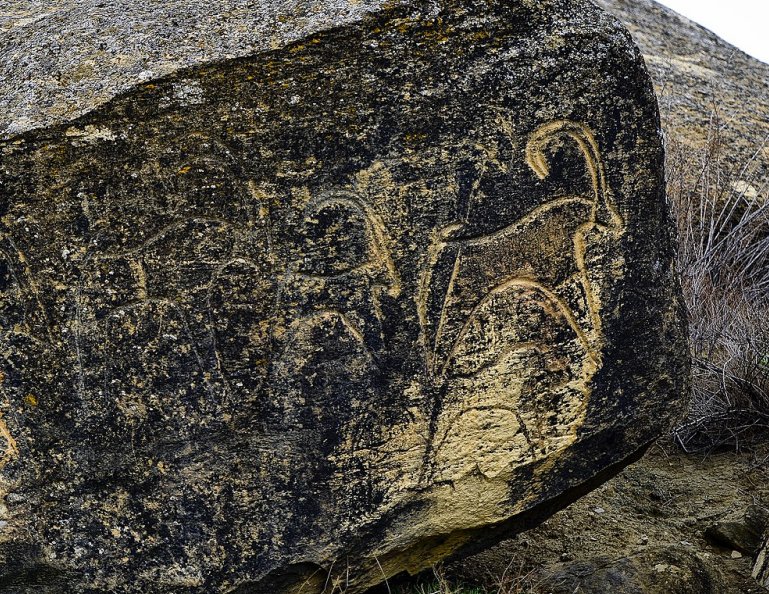
Stone Age rock carving in Azerbaijan identified by the ID. Image credit: Erdalturkoglu – CC BY-SA 4.0
It’s one of Gobustan’s most famous petroglyphs depicting dancers in Azerbaijan’s traditional Yalli dance, where participants form a circle or chain and dance holding hands or shoulders.
They can be found in countless caves, and rock outcroppings surround the region of the south-eastern spur of the Great Caucasian Mountain Range, located only 60 km south of Baku, and they tell stories dating back to deep antiquity.
The petroglyphs of Gobustan attest to the incredible creativity, complexity, and diversity of primitive man (perhaps shepherds, fishermen) who once inhabited the Caspian land that is considered by many as one of the cradles of civilization and its history goes back millennia.
Depictions Of Prehistoric Life In The Caucasus
In total, 6,000 cave drawings have been counted in Gobustan. They depict hunters, breeders, and houses with burning fire, which was crucial for these people, and a large part of their daily activities focused on maintaining a fire.
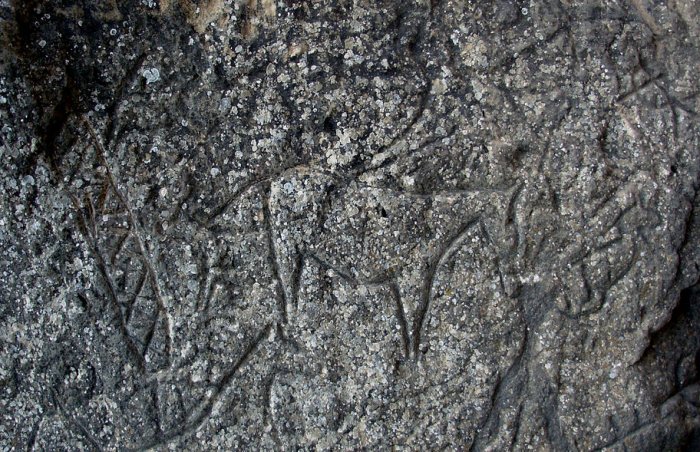
Gobustan, Azerbaijan 2008 – Image credit: Abu Zarr – CC BY-SA 3.0
Countless drawings carved in the rock illustrate daily life activities, funeral ceremonies, and fascinating human figures. Men are depicted in hunting robes – with bows and arrows. They are tall, with slender bodies with well-developed muscles. Other images show recreated ritual dances, hunting scenes, fights, people sitting in reed boats, dancing women, pregnant women, and above them, dominating the sky, sun, and stars.
In female images, busts and hips are especially clearly depicted by artists, but the figures have no hands.
All animals are depicted very realistically and so accurately that they allow the identification of many different species. There are many images of animals like deer, gazelles, deer, wild goats, horses, pigs, lions, and bulls. Pictures of birds, fish, snakes, lizards, and insects exist.
Curiously, the most realistic drawings are the oldest.
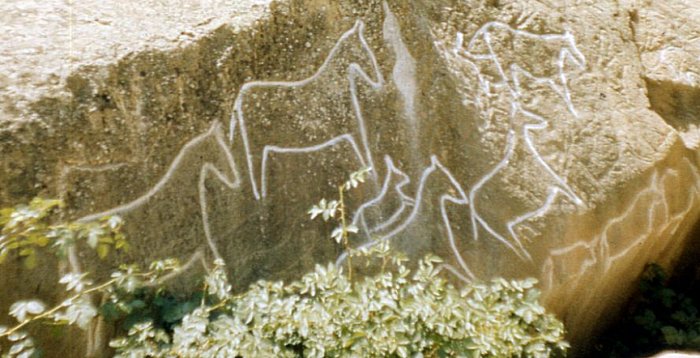 Gobustan rock art. Source
Gobustan rock art. Source
The Gobustan drawings (many thousands of years old) show people wearing lightweight clothing suitable for the warm climate that began to dominate when Earth’s last ice age ended about 12,000 years ago.
Petroglyphs Were Discovered Accidentally
The petroglyphs were found accidentally during work in a stone quarry in the 1930s. A few years later, many of them were recorded and preserved. On average, they date back to 5,000-20,000 years.
First, very simple carvings were later covered by more complex ones. Human figures had small heads without noses, mouths, eyes, or ears. According to researchers, missing facial features does not necessarily mean that artists who left this rock art lacked technical skills because other carvings are much more complex and detailed.
Gaval Dash – Amazing Musical Stone
The Gaval Dash (or “gaval chalan dash”) is a natural musical stone found only in Gobustan, Azerbaijan. It is a large flat stone with unique properties.
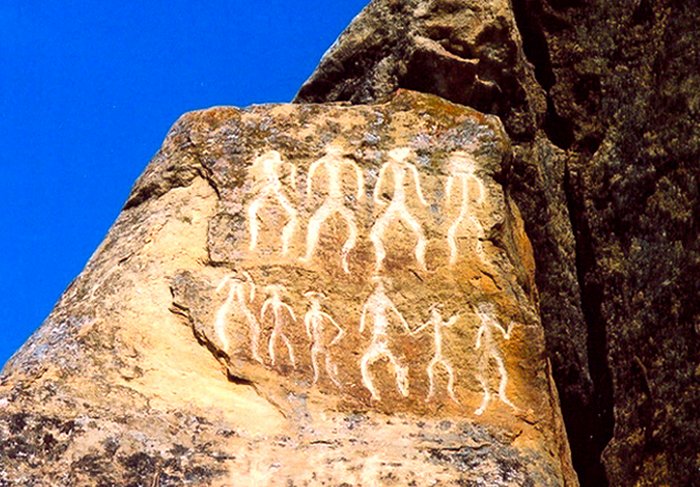 Rock engravings in Gobustán dating back 10,000 years ago. It’s one of Gobustan’s most famous petroglyphs depicting dancers taking part in Azerbaijan’s traditional Yalli dance, where participants form a circle or chain and dance holding hands or shoulders. Source
Rock engravings in Gobustán dating back 10,000 years ago. It’s one of Gobustan’s most famous petroglyphs depicting dancers taking part in Azerbaijan’s traditional Yalli dance, where participants form a circle or chain and dance holding hands or shoulders. Source
While touched with a small stone, the Gaval Dash “responds” with a musical sound similar to that of a tambourine. Therefore, it is sometimes called a ‘tambourine stone.’
This mostly unusual instrument may have been used in the traditional rhythmic music of Azerbaijan that accompanied the famous Yalli dancers.
The Gaval Dash has been formed due to the combination of unique climate, oil, and gas found in the Azerbaijan region.
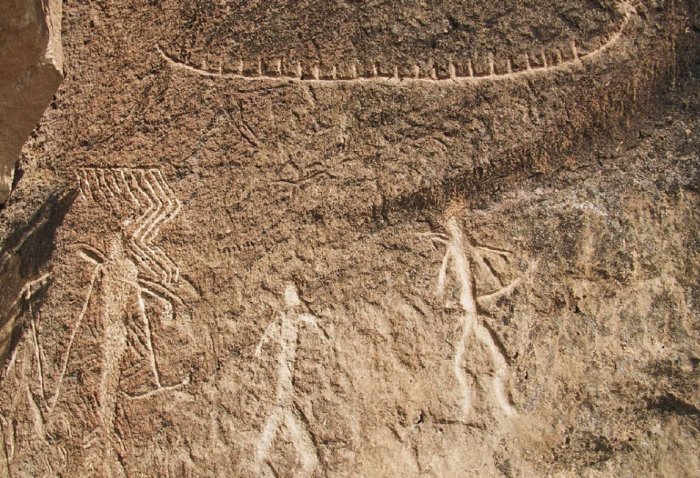 Petroglyphs in Gobustan. Zigzags indicate rain and clouds. Source
Petroglyphs in Gobustan. Zigzags indicate rain and clouds. Source
Gobustan’s And Scandinavia’s Reed Boats
Thor Heyerdahl, Norwegian archaeologist, ethnographer, and researcher, traveled to Gobustan and investigated rock art. Heyerdahl suggested that Azerbaijan was the site of an ancient advanced civilization, and its natives traveled through the waterways to Scandinavia in their innovative vessels built of leather.
Probably about 100 AD, they shared their boat-building skills with the Scandinavians and even modified the boats we know today from excavations in Northern Europe, especially in Heyerdahl’s native Norway. Based on the archeological finds and the petroglyphs depicting long boats similar to the Viking ships, Heyerdahl theorized that the ancestral people of Scandinavians probably originated from the region now identified as Azerbaijan.
He saw similarities between the petroglyphs of Gobustan and reed boats in cave drawings in Scandinavia.
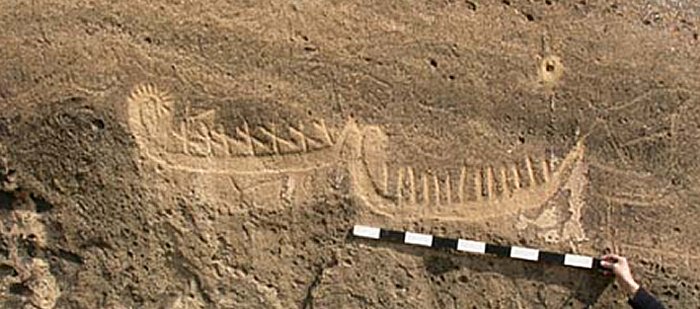 Gobustan boats preceded the boats later seen on rocks of Egypt and Algerian Sahara and dated by 7th-5th BC. Image source.
Gobustan boats preceded the boats later seen on rocks of Egypt and Algerian Sahara and dated by 7th-5th BC. Image source.
The most ancient boats are linear ones, counted for 2-4 people. The shining sun images decorate the stern of other ships.
These were quite big boats, and they could take up to 40 people. Their depictions were widespread in the countries of historical Mesopotamia. The boat images of Gobustan are dated to a more ancient period. Gobustan boats preceded the boats later seen on rocks of Egypt and Algerian Sahara and dated by 7th-5th BC.
Written by – A. Sutherland – AncientPages.com Senior Staff Writer
Updated on January 4, 2024
Copyright © AncientPages.com All rights reserved. This material may not be published, broadcast, rewritten or redistributed in whole or part without the express written permission of AncientPages.com
Expand for references
References:
Source1
Academia.edu
UNESCO





